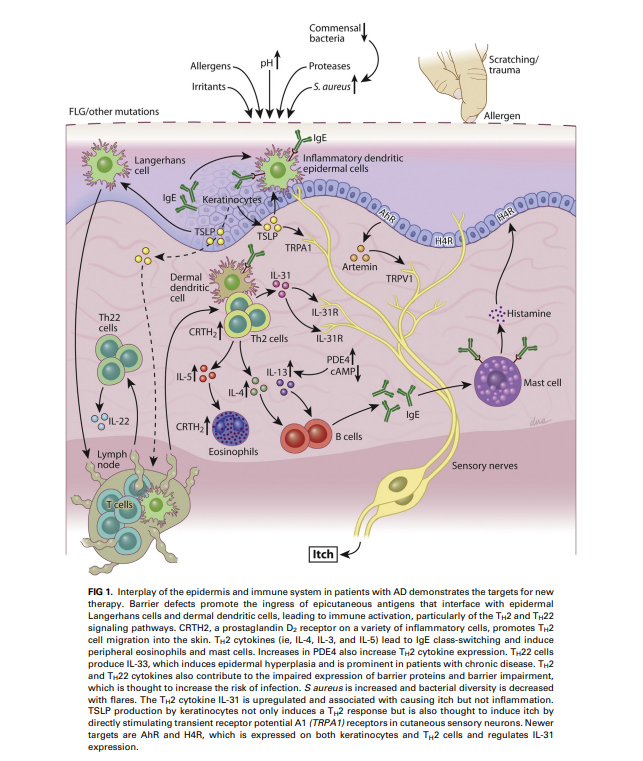Synergy or “the total is larger than the sum of the parts”.
Why are Skin Actives ingredient lists so long? It’s not because of “label value”, the skincare industry practice that uses plant Latin names to hide the “baddies” and make you think you are getting value for money. Not at all. Each ingredient in our list has a good reason to be there. We at Skin Actives understand how complex the skin is. To address a skin problem, or to improve skin health, or reverse skin aging, we need to address that complexity, and this is how our ingredient lists become so long.
Look, for example, at how eczema develops (for a more detailed explanation, please see this post). You have to be a biochemist specializing in allergy to understand how this system works. And the figure shows a work in progress, like all the cartoons that claim to depict how a human system works properly and how it starts to malfunction. You need to understand anatomy, biochemistry, microbiology, and how this system interacts with the environment.

The idea behind Skin Actives is to look at the up-to-date research on a skin problem and extract the information that can help formulate a product that is safe and effective at the same time. To do this I have to ignore “novelty” ingredients and those known to have side effects. I then look at the ingredients, both natural and laboratory-made, that address the different pathways involved in the problem and choose those most likely to be helpful. For example, tea tree oil may be an effective antimicrobial but it’s also a very common allergen. Balsam of Peru may smell nice but it’s also very allergenic. You will not find these in our ingredient lists.
What you will find: epidermal growth factor, a laboratory-made protein that is identical to the human epidermal growth factor that decreases as we age and can work beautifully on our aging skin.
You will find apocynin, a natural, re-discovered ingredient that promotes the anchoring of new epidermal cells just produced by our skin stem cells.
Bee defensin, a laboratory-made protein identical to the one that gives bee royal jelly its antibacterial and antifungal properties and helps accelerate skin healing. This is the way to get the benefits of royal jelly in a concentrate, using the knowledge of modern science applied to ancient medical practice.
Kefir bioferment, uses sea kelp with all its benefits and adds on the chemicals produced by kefir microorganisms, producing a gel that benefits the “good” skin microbiota, dissuades the bad microorganisms, and modulates the skin immune system.
Xanthohumol, a chemical present in hop, has anti-inflammatory, antioxidant, antimicrobial, and prebiotic properties.
We have a full complement of antioxidant human proteins, produced in the laboratory and ready to protect your skin from environmental oxidants and UV.
I don’t want to make this post twenty pages long enumerating all the innovative but safe ingredients we have added to the skincare armamentarium, but search among my almost thousand posts for all the scientific knowledge we have incorporated to benefit our skin.
References
Bucekova, M., Sojka, M., Valachova, I. et al. Bee-derived antibacterial peptide, defensin-1, promotes wound re-epithelialisation in vitro and in vivo . Sci Rep 7, 7340 (2017). https://doi.org/10.1038/s41598-017-07494-0
Lolou, V.; Panayiotidis, M.I. Functional Role of Probiotics and Prebiotics on Skin Health and Disease. Fermentation 2019, 5, 41. https://doi.org/10.3390/fermentation5020041
DISCLAIMER: These claims have not been evaluated by the FDA and are not intended to diagnose, cure, treat or prevent any disease.
